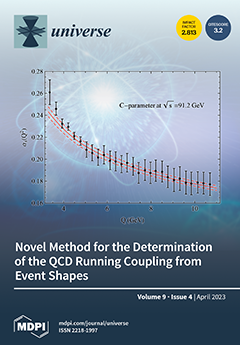A new dynamical paradigm merging quantum dynamics with cosmology is discussed. We distinguish between a universe and its background space-time. The universe here is the subset of space-time defined by
, where
is a solution of a Schrödinger equation,
x is a point in
n-dimensional Minkowski space, and
is a dimensionless ‘cosmic-time’ evolution parameter. We derive the form of the Schrödinger equation and show that an empty universe is described by a
that propagates towards the future inside some future-cone
. The resulting dynamical semigroup is unitary, i.e.,
for
. The initial condition
is not localized at
. Rather, it satisfies the boundary condition
for
. For
the support of
is bounded from the past by the ‘gap hyperboloid’
, where
ℓ is a fundamental length. Consequently, the points located between the hyperboloid and the light cone
satisfy
, and thus do not belong to the universe. As
grows, the gap between the support of
and the light cone increases. The past thus literally disappears. Unitarity of the dynamical semigroup implies that the universe becomes localized in a finite-thickness future-neighbourhood of
, simultaneously spreading along the hyperboloid. Effectively, for large
the subset occupied by the universe resembles a part of the gap hyperboloid itself, but its thickness
is non-zero for finite
. Finite
implies that the three-dimensional volume of the universe is finite as well. An approximate radius of the universe,
, grows with
due to
and
. The propagation of
through space-time matches an intuitive picture of the passage of time. What we regard as the Minkowski-space classical time can be identified with
, so
grows with
as a consequence of the Ehrenfest theorem, and its present uncertainty can be identified with the Planck time. Assuming that at present values of
(corresponding to 13–14 billion years)
and
are of the order of the Planck length and the Hubble radius, we estimate that the analogous thickness
of the support of
is of the order of 1 AU, and
. The estimates imply that the initial volume of the universe was finite and its uncertainty in time was several minutes. Next, we generalize the formalism in a way that incorporates interactions with matter. We are guided by the correspondence principle with quantum mechanics, which should be asymptotically reconstructed for the present values of
. We argue that Hamiltonians corresponding to the present values of
approximately describe quantum mechanics in a conformally Minkowskian space-time. The conformal factor is directly related to
. As a by-product of the construction, we arrive at a new formulation of conformal invariance of
fields.
Full article





